STORY HIGHLIGHTS
- The Shahnameh, a 1,000-year old Persian epic, is a cultural mainstay in Iran.
- Iranian filmmaker Hamid Rahmanian recently made a contemporary, illustrated version.
- Each page is composed of thousands of parts scanned from Persian miniatures and lithographs.
- The story is made up of strong women who “sexually conquer” their men.
(CNN) — Few books truly invade a national psyche. When a work manages to do so for 1,000 years, it’s a pretty spectacular feat.
Enter “Shahnameh“, or Book of Kings, a literary epic so large (the largest, in fact) that it measures the length of Homer’s “Iliad” and “Odyssey” combined. It is one of Iran’s national treasures, and holds a place next to the Quran in many Iranian households.
It is difficult to overestimate the importance of “Shanameh” in Iranian culture. Even today, it remains a staple in the canon of bedtime literature read to children. It is among the first books taught in Iranian classrooms.
Political candidates will reference parables from the tome in election speeches. During the protests that characterized the 2009 elections, demonstrators adopted the chant, “We are all Sohrab,” a reference both to a 19-year old victim killed by security forces, and to one of poem’s tragic heroes.
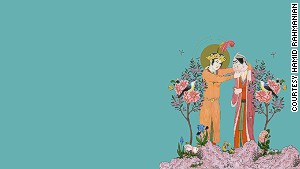
From Hamid Rahmanian’s modern English language “Shahnameh”
The women in these stories basically hunt and sexually conquer their men.
Ahmad Sadri, translator
Almost as impressive as the text itself is the commitment of its author. A Persian poet by the name of Ferdowsi dedicated 30 years of his life to collecting folklore, mythologies and oral histories and turning it into 60,000 rhyming couplets. Today, Ferdowsi has found a disciple in the form of Hamid Rahmanian, a Brooklyn-based Iranian filmmaker who has logged over 10,000 hours illustrating an elaborate new English translation.
“He didn’t have a computer,” quips Rahmanian. “If he did, it wouldn’t have taken him 30 years.”
Rather than sketch the book from scratch, Rahmanian crafted together thousands of images of Persian art and painstakingly layered them in what amounts to a 500-page collage.
“I wanted to introduce the visual culture of the Persians and create something modern,” he explains.
Interactive: Press freedom in the Middle East
“Painting struck me as very passé; no one sits down and paints anymore. I wanted to be like a DJ, but instead of collecting sound and music and changing the tempo or tone to create a new composition, I would use lithographs and miniatures from the 14th to early 19th century.”
Sheila Canby, the curator of Islamic Art at the Metropolitan Museum of Art in New York, has dubbed Rahmanian’s version “the ‘Shahnameh’ of the digital age”.
“His is both a departure and an evolution,” she says. “The book is slick and modern, and very much informed by the visual universe of the internet and TV and film.”
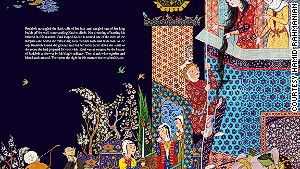
Western readers may be familiar with Zaul, meeting his lover by climbing her locks.
Ahmad Sadri, the chairman of the Islamic World Studies Department at Michigan’s Lake Forest College, provided the English translation, and — along with Rahmanian’s wife, Melissa Hibbard — helped to bring the language alive for 21st century, English-speaking audiences.
I wanted to be like a DJ, but instead of collecting sound I would use lithographs from the 14th century.
Hamid Rahmanian
“This is the world that has been used to the language of movies for 100 years — since the invention of American film. The people we are trying to reach are used to fanciful stories like ‘Lord of the Rings’ and ‘Star Wars.’ I couldn’t pretend that they didn’t already have that exposure,” explains Sadri.
“To keep the reader hooked and addicted to the narrative, Melissa and I made the decision to tell a character-driven, rather than event-driven story.”
Read more: Arab cartoonists court controversy
While Western readers may have had limited contact with the epic, several of the tales encapsulated in the work should look familiar. In one love story, the hero, Zaul, meets his beloved by climbing up her ladder-like locks. The stars of that tale are also star-crossed in a similar manner to their romantic successors, Romeo and Juliet. Other narratives have elements of “Oedipus Rex” and even Tarzan (the orphaned babe raised by wild animals).
What Sadri finds most fascinating, however, is the role of women in the saga.
“It’s amazing, because they’re anything but passive,” he notes.
“The women in these stories basically hunt and sexually conquer their men. They are advisers — not shy to offer their opinion. There are villainous women and heroic women.”
Perhaps one of the most riveting stories, though, is that of Ferdowsi himself, who after dedicating his life to collecting stories, died bankrupt and embittered. It is a situation that Rahmanian can appreciate. He funded much of the project himself, and during the nearly four years he worked on it, was pulling in little else by way of an income. Halfway through the project, Hibbard fell pregnant.
“Two weeks before my daughter was born, I had $27.37 in my bank account. I told Melissa take a screen shot,” he recalls.
“You have to have a certain passion and love and belief to sit down with no money and make something like that,” he says.
Continue reading:
The post Sex, lies, lithographs appeared first on Arne Ruhnau News.
via Arne Ruhnau News http://arneruhnau.com/sex-lies-lithographs/
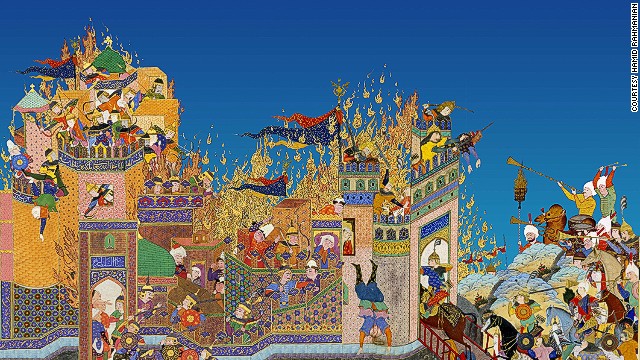 Persian filmmaker Hamid Rahmanian has made a contemporary translation of the Iranian epic, Shahnameh, for the digital age.
Persian filmmaker Hamid Rahmanian has made a contemporary translation of the Iranian epic, Shahnameh, for the digital age. 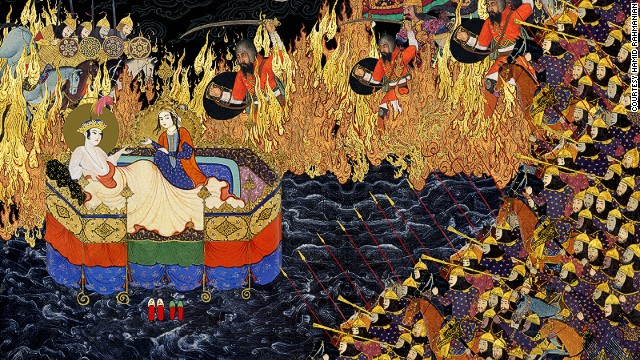 Rahmanian collected over 8,000 Persian miniatures and lithographs, which he then scanned, retouched, and used to create a multi-layered collage. Each page of his 500-page remastering is comprised of hundreds of individual elements.
Rahmanian collected over 8,000 Persian miniatures and lithographs, which he then scanned, retouched, and used to create a multi-layered collage. Each page of his 500-page remastering is comprised of hundreds of individual elements. 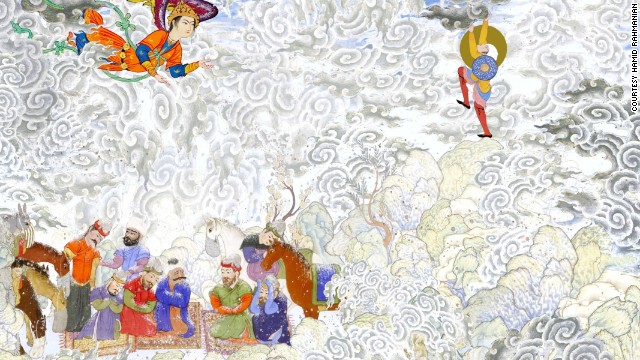 The Shahnameh is the longest poem every written. It’s is bigger than the Iliad and Odyssey combined.
The Shahnameh is the longest poem every written. It’s is bigger than the Iliad and Odyssey combined.  A filmmaker and graphic artist, Rahmanian tried to give the illustrations a movie-like quality.
A filmmaker and graphic artist, Rahmanian tried to give the illustrations a movie-like quality. 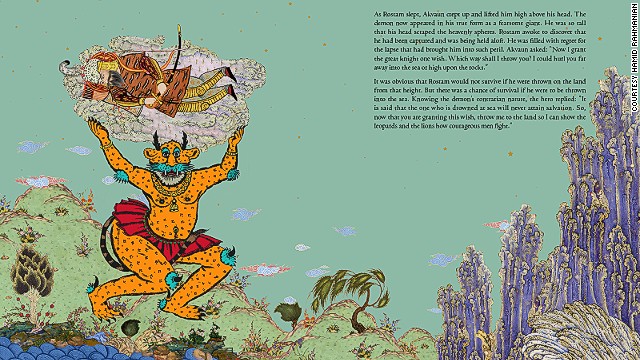 Ahmad Sadri, a professor of sociology and anthropology at Lake Forest College, translated the text into English prose.
Ahmad Sadri, a professor of sociology and anthropology at Lake Forest College, translated the text into English prose.  Sadri worked to breathe life into the English translation, while making it relatable to a 21st century audience.
Sadri worked to breathe life into the English translation, while making it relatable to a 21st century audience. 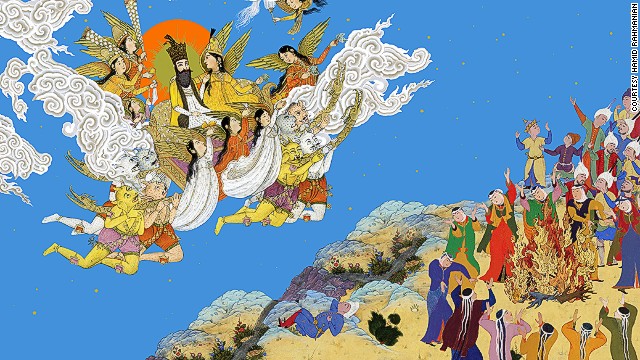 Though there is a long history of visual versions of the Shahnameh, illustrating the text has fallen out of fashion of late. Rahmanian’s version is one of the first graphic renditions to hit the shelves in 100 years.
Though there is a long history of visual versions of the Shahnameh, illustrating the text has fallen out of fashion of late. Rahmanian’s version is one of the first graphic renditions to hit the shelves in 100 years.  The Shahnameh’s original author, Abol Ghassem Mansor , spent 30 years gathering Persian folklore, myths and histories, before compiling it into his epic poem.
The Shahnameh’s original author, Abol Ghassem Mansor , spent 30 years gathering Persian folklore, myths and histories, before compiling it into his epic poem.  Many of the Shahnameh’s tales, including that of Zaul and Rudabeh (pictured) were the basis for some of the English language’s most famous stories.
Many of the Shahnameh’s tales, including that of Zaul and Rudabeh (pictured) were the basis for some of the English language’s most famous stories. 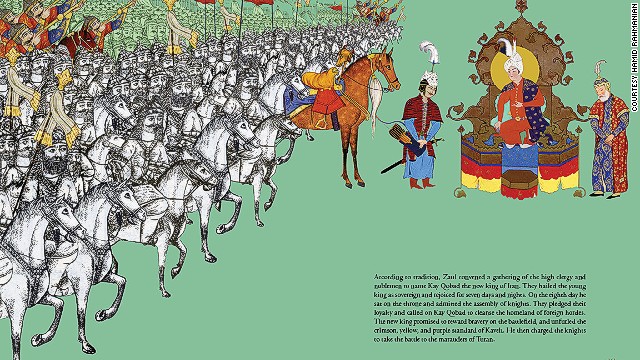 Though the epic was written 1,000 years ago, the Persian narrative is as readable to today’s Iranians as it was ancient Persians. The reason for this is that Farsi has remained fairly consistent over the years.
Though the epic was written 1,000 years ago, the Persian narrative is as readable to today’s Iranians as it was ancient Persians. The reason for this is that Farsi has remained fairly consistent over the years. 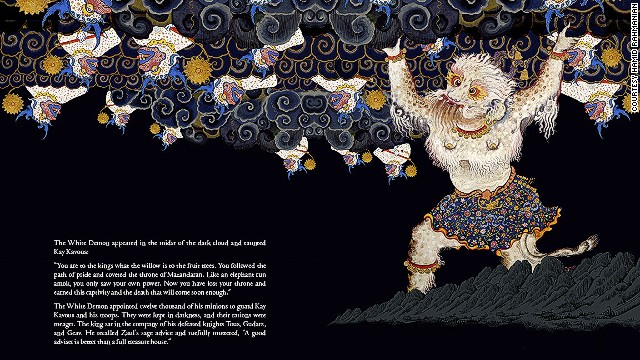 Despite its age, the Shahnameh has remained a touchstone of the Iranian psyche. Many children are still read to sleep with the ancient verses.
Despite its age, the Shahnameh has remained a touchstone of the Iranian psyche. Many children are still read to sleep with the ancient verses. 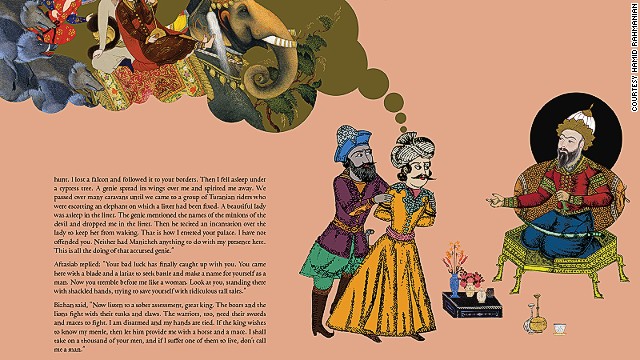 Fans of Shakespeare may find the tale of Bizhan and Manizheh familiar. The story depicts star crossed lovers from warring families.
Fans of Shakespeare may find the tale of Bizhan and Manizheh familiar. The story depicts star crossed lovers from warring families. 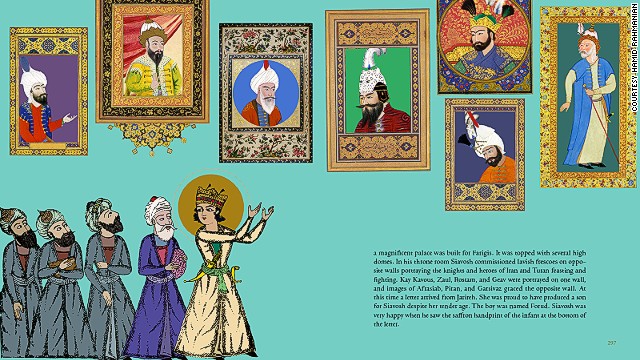 The Shahnameh is often credited with preserving the Persian language following the Arab Conquest of the 7th century.
The Shahnameh is often credited with preserving the Persian language following the Arab Conquest of the 7th century. 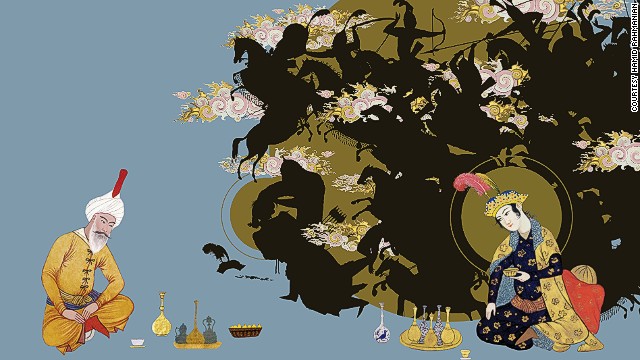 Rahmanian collected lithographs and miniatures from the 14th to 19th century. Some characters, he says, are compilations of 500 years of history.
Rahmanian collected lithographs and miniatures from the 14th to 19th century. Some characters, he says, are compilations of 500 years of history. 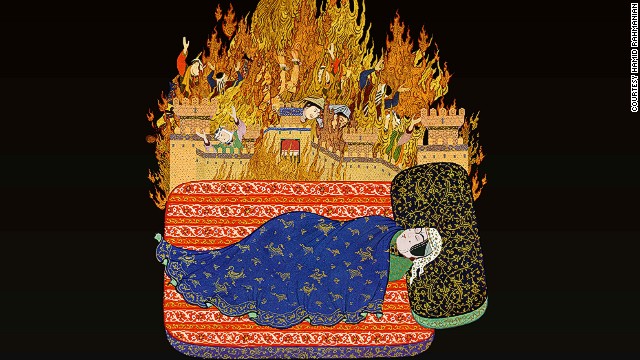 Rahmanian envisions himself as a visual DJ. ‘Instead of collecting sound and music and changing the tempo or tone to create a new composition, I created something with miniatures and lithographs,’ he says.
Rahmanian envisions himself as a visual DJ. ‘Instead of collecting sound and music and changing the tempo or tone to create a new composition, I created something with miniatures and lithographs,’ he says. 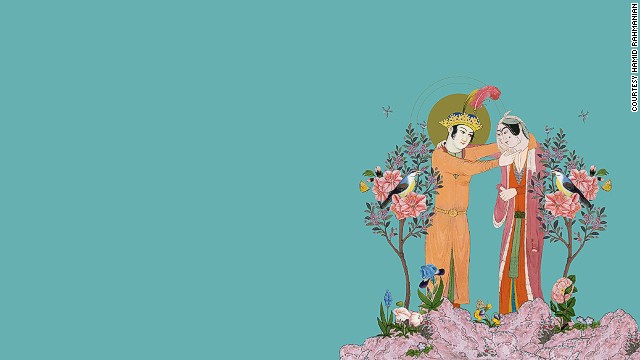 Sheila Canby, head of the Metropolitan Museum’s Department of Islamic Art, notes that Rahmanian uses a much more cinematic palette than his predecessors.
Sheila Canby, head of the Metropolitan Museum’s Department of Islamic Art, notes that Rahmanian uses a much more cinematic palette than his predecessors. 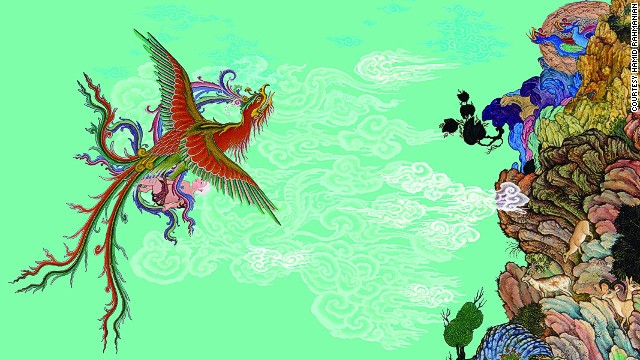 Rahmanian says the story of Zaul (pictured), who was raised by a mythical bird, is mimicked by modern tales, such as Disney’s ‘The Jungle Book’.
Rahmanian says the story of Zaul (pictured), who was raised by a mythical bird, is mimicked by modern tales, such as Disney’s ‘The Jungle Book’. 
















No comments:
Post a Comment